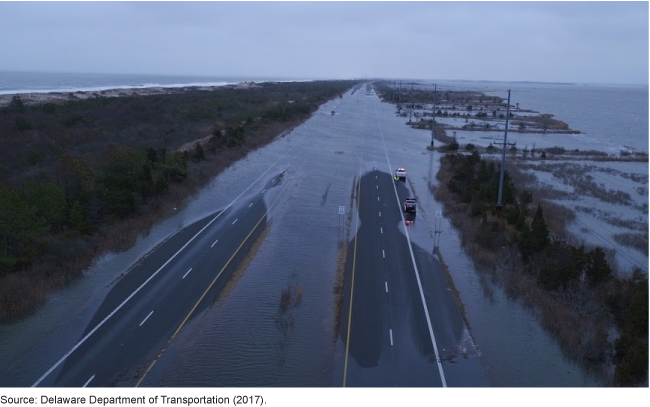Climate Resilience: Opportunities to Improve Federal Planning and Implementation
Fast Facts
Natural disasters in the U.S. have caused an average of almost $150 billion in damages per year over the past five years. These costs are likely to rise as the climate changes, creating a key source of federal fiscal exposure (see our High Risk List).
We testified that applying the 3 principles in our Disaster Resilience Framework—information, integration, and incentives—can help promote climate resilience.
For instance, a national climate information system could help provide authoritative information for federal decision making. Federal incentives could also encourage risk-reduction investments in state and local infrastructure projects.
Flooding on Delaware State Route 1

Highlights
What GAO Found
Disaster costs are projected to increase as certain extreme weather events become more frequent and intense due to climate change, as observed and projected by the U.S. Global Change Research Program and the National Academies of Sciences, Engineering, and Medicine. GAO's Disaster Resilience Framework can serve as a guide for analyzing federal action to facilitate and promote resilience to natural disasters and the effects of climate change. The framework is organized around three guiding principles—information, integration, and incentives (see figure)—that can help Congress and federal agencies improve federal climate resilience planning and implementation.
Figure 1: GAO's Disaster Resilience Framework Principles

Information. Congress and federal agencies can help decision makers access climate information that is authoritative and understandable. For example, in November 2015, GAO reported that the federal government needs a government-wide approach for providing decision makers with authoritative climate information. GAO recommended that the Executive Office of the President (EOP) designate a federal entity to develop and update such information and designate a federal entity to create a national climate information system. EOP neither agreed nor disagreed with the recommendations and had not implemented them as of March 2022.
Integration. Congress and federal agencies can help decision makers integrate analysis and planning to take coherent and coordinated resilience actions. For example, in March 2021, GAO reported that the Department of Energy did not have a department-wide strategy to enhance the resilience of the electricity grid to the risks of climate change. GAO recommended that the department develop and implement such a strategy. The department agreed in principle with this recommendation, but its proposed actions do not fully address it.
Incentives. Congress and federal agencies can make risk-reduction investments more viable and attractive. For example, in September 2021, GAO identified a suite of policy options the Federal Highway Administration could take to incentivize states and localities to enhance the climate resilience of federally funded roads. GAO suggested that Congress direct the agency to implement one or more of these options, and to give it statutory authority to do so.
Why GAO Did This Study
The increasing number of natural disasters in the U.S. and reliance on federal assistance to address them are sources of federal climate-related fiscal exposure. Limiting the Federal Government's Fiscal Exposure by Better Managing Climate Change Risks has been on GAO's High-Risk List since 2013, in part because of the increasing costs of federal disaster response and recovery efforts. For example, from fiscal years 2015 through 2021, select appropriations for disaster assistance totaled $315 billion.
GAO has previously found that enhancing climate resilience could help limit future costs. Enhancing climate resilience means taking actions to reduce potential future losses by planning and preparing for potential climate hazards. Agencies have taken some actions, including in the areas of climate resilience planning.
This testimony focuses on how Congress and federal agencies can improve climate resilience planning and implementation by applying principles of GAO's Disaster Resilience Framework. This testimony is based on findings and methodologies of GAO reports on climate resilience from May 2011 through September 2021.
Recommendations
Since 2003, GAO has made 84 recommendations and suggested six matters for congressional consideration related to enhancing climate resilience and limiting the federal government's fiscal exposure to climate change. As of March 2022, 31 recommendations are not yet implemented.
